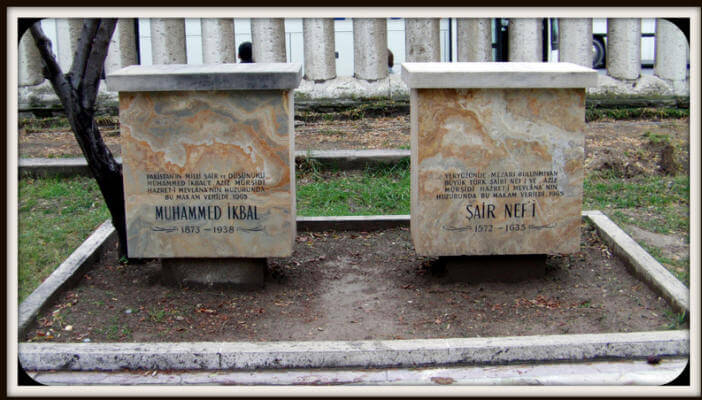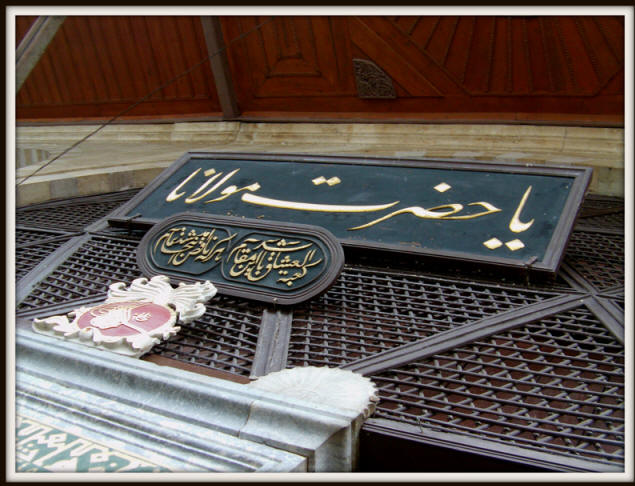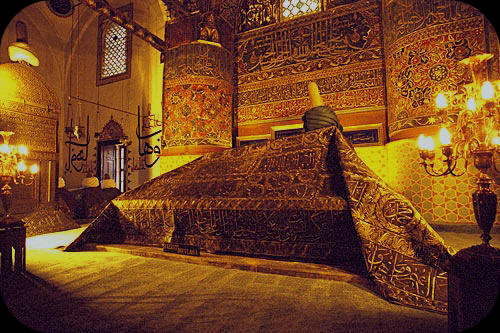When speaking of Mevlana Rumi, I cannot think of a better eulogy paid by Allama Iqbal in Bal-e-Jibreel (The Wings of Gabriel) to his spiritual master.
يورپ سے ايک خط
ہم خوگر محسوس ہيں ساحل کے خريدار
اک بحر پر آشوب و پر اسرار ہے رومي
تو بھي ہے اسي قافلہء شوق ميں اقبال
جس قافلہء شوق کا سالار ہے رومي
اس عصر کو بھي اس نے ديا ہے کوئي پيغام؟
کہتے ہيں چراغ رہ احرار ہے رومي
جواب
کہ نبايد خورد و جو ہمچوں خراں
آہوانہ در ختن چر ارغواں
ہر کہ کاہ و جو خورد قرباں شود
ہر کہ نور حق خورد قرآں شود
Translation:
A LETTER FROM EUROPE
We venture not beyond the shores—
Being to the senses confined.
But Rumi is an ocean,
Stormy, mysterious.
Iqbal! You, too, are moving
In that band of men–
That band of men of passion,
Of which Rumi is the guide,
Rumi, they say,
Is the guiding light for freedom;
Has he, indeed, a message,
For the age we live in?
(Mevlana Rumi’s) REPLY
‘Eat not hay and corn like donkeys;
Eat of thy choice like the musk-deer;
He dies who eats hay and corn,
He who eats God’s light, becomes the Quran.’
Below is my account of the pilgrimage to the shine of Mevlana Rumi (known as Mevlana Rumi Museum) in Konya. The only reason to share is because it may be useful for anyone who wishes to pay a visit to the greatest mystic. The Turkish word Mevlana is a derivation from Arabic/Persian Maulana, which means ‘our master’.
Mevlana Rumi’s Urs takes place between 9-13th December every year in Konya, which is key event for this beautiful small city. The word Urs is a derivation from the Persian word Uroos, which means a Bride. Urs is celebrated on the day saints or sufis passed away to unite with their Lord, thus calling it the night of wedding or companionship.
It reminds me of an incident I read in the prelude of my copy of Masnavi, which is translated into Urdu by Qazi Sajaad Hussain. It is narrated, when Mevlana Rumi’s last time arrived, a Hakim arrived for prognosis. The Hakim wept after seeing Mevlana’s condition as he realised there is nothing he can do. Mevlana asked him not to weep and remarked, “Can you see that there is only thin veil left behind between the Khaliq (The Creator) and Maklooq (The Creation) now?”.
In terms of logistics, I took the Meram Express from HyderPasha train station, Istanbul to Konya. You can book advance tickets on the http://www.tcdd.gov.tr/anasayfa ,however it can be quite confusing. It is almost a 14 hour overnight journey. However, Meram Express is a modern and clean train and as good as trains train in West.
There are 2 main option for tickets: Pullman which is basically a seat that reclines or a Sleeper which is a private room which two beds, personal sink, fridge with snacks and savouries. There are some useful photos available here on seat61 website. I purchased a Pullman ticket option from Istanbul to Konya which cost Turkish Lira (TL) 28 (= GBP 11) and returned to Istanbul by single sleeper for TL 78 (equivalent to approx GBP 31). I would recommend the sleeper despite being a little expensive as it is a long journey and can be unconformable on a reclining seat. If you’re travelling on a Pullman, I would suggest bringing blankets and pillow as none are provided. Konya can be quite colder in temperature in winters so warm clothing is a must.
I reached Konya around 8am in the morning. Mevlana Museum is around 3 kilometre but I took a walk to view the city also. A Google map is below to provide direction and it is straight 30 minutes brisk walk.
I do suggest to walk into a few shops to buy souvenirs of Konya which include lovely ceramics of whirling dervishes, small cups for Turkish tea, key rings, fridge magnets, vases etc. I found Shopkeepers in Konya very friendly just like Istanbul and be prepared to be asked where you come from, how did you like Konya etc. Shopping in Turkey is more personal than sticking bar-codes to items as in the West and the usual beeps!
Mevlana Rumi Museum is a key tourist site for this small city so expect a little crowd especially during the Urs time. You will observe tour buses parked outside which provide guided tours to local as well as international tourists. Mevlana Museum is well organised site and you can get literature in English, Spanish, French and other main languages. I took a guide in Turkish (by error!) which is available below to be downloaded in PDF format.
Mevlana Muesum [Rumi Tomb, Konya] Visitors Guide
Since photography is prohibited within the shrine area, it provides some good photos of shrine and museum area.
Audio tour guides are a great way to learn since these provide audio commentary for the key highlights of the place by pressing the number associated to it. The garden outside the shrine is called Rose Garden for reason obvious. Konya, like the rest of Turkey, boasts a huge variety of flowers and especially the fruit tastes better than anywhere else.
As you enter the gate of the shrine, you will see graves of many personalities with most having a mevlevi turban on the headstone. One of the striking one is a tombstone of Allama Iqbal (Muhammad Ekbal), which is not the actual final resting place of the great philosoper but an honour granted to Allama for his immense reverence for Mevlana Rumi, see below.
Honoury grave of Allama Muhammad Iqbal at Mevlana’s Shrine. Mevlana Muesum [Rumi Tomb, Konya] Visitors Guide
In Javed Naama, Allama provides his advice to his son, Javed Iqbal:
گر نیابی صحبت مرد خبیر
از اب وجد آنچہ من دارم بگیر
پیر رومی را رفیق راہ ساز
تا خدا بخشد ترا سوز و گداز
زانکہ رومی مغز را داند ز پوست
پای او محکم فتد در کوی دوست
Translation:
If you do not find the company of an enlightened one (mentor of truth)
Then take from me the knowledge, which I attained from my ancestors
Make Rumi your guide for the (true) path.
So God bless you with ecstasy of love
Rumi knows what is real (fruit) from what is superficial (skin)
His feet are firm in the place of the Friend (God).
Entrance of Mevlana Rumu’s shrine. At the main shrine door, you will see ‘Ya Hazrat Maulana’ written at the door.
Kaaba al Ushaaq Ba-en Shud Muqaam ,
Har Ke Naaqis Anja Shud Tamaam
(This is the Ka’aba (mecca) of all Lovers,
It converts an unpure one into a pure one)
Here you will be given polythene shoe covers as you enter the holy shrines hall. Once in the shrine main hall, you will observe many tombs until you reach Mevlana’s tomb which is represented by the largest turban on its headstone, see below.
Tomb of Mevalan Rumi. The epitaph reads, ‘When we have gone, seek us not in our tomb, but in the heart of enlightened
Offered Fatih and Surah Yasin as you will observe many people doing the same. You will observe people constantly moving in a queue going in both directions which ensures there is constant flow of pilgrims. There is a Mevlana Museum adjacent to the main hall which exhibit texts of Masnavi, musical instruments including Neh and many of Mevlana and other awliyas’s personal belonging.
As a part of Ataturk reform for modernisation in 1925, Sufi brotherhoods were not allowed to perform the whirling ceremonies publically and were practically dissolved. Mevlana’s shrine was converted in Mevlana Museum which opened in 1927.In 1954, a special permission was granted by the Turkish Government lifting the ban on Samaa. The tomb of Rumi is now the primary tourist site of Konya attracting pilgrims all over the world who come to pay their tribute and homage to their dear Mevlana.
The Mawlawi Whirling Dervishes of Konya have gained popularity and recognition especially in the West with its eye catching ceremonies. Samaa, as the whirling ceremony is called, is a deeply religious ritual, associated with Mevlana Rumi.
There are 7 key stages which have been explained beautifully at http://www.mevlana.org/sema.html.
I retuned back to Istanbul via Meram Express and could not attend the ceremony of whirling dervishes unfortunately which I believe happens in the Rose Garden. This is a beautiful ceremony with much deeper meaning than a physical revolutions. Inshallah I will provide a more detailed account of this in a separate article later. I met another pilgrim briefly as I reached HyerPasha station who I recognised immediately from his Mevlana Turban. He visited perhaps all the way from Australia and had intense reverence for Mevlana Rumi. I requested him for blessing and he raised his hands to pray for me. I kissed his hands and said my farewell. It was poignant journey and i felt that despite back in Istanbul, the heart is still in Konya.
I have uploaded a few amateur video on Youtube also, in case they can be helpful.
Iltimaas-e-Dua (request for prayer), if you are one of the fortunate ones to be at this blessed place.
WK
Feb 2011.
The post A pilgrimage to Maulana Rumi Mausoleum (Mevlana Museum), Konya, Turkey appeared first on TheSufi.com.

![konya - map from station to mevlena museum [rumi's shrine]](http://www.thesufi.com/wp-content/uploads/konya-map-from-station-to-mevlena-museum-rumis-shrine.jpg)



